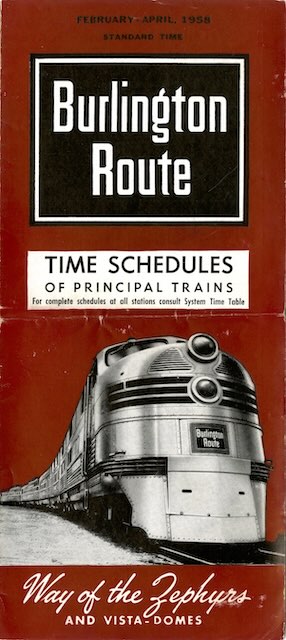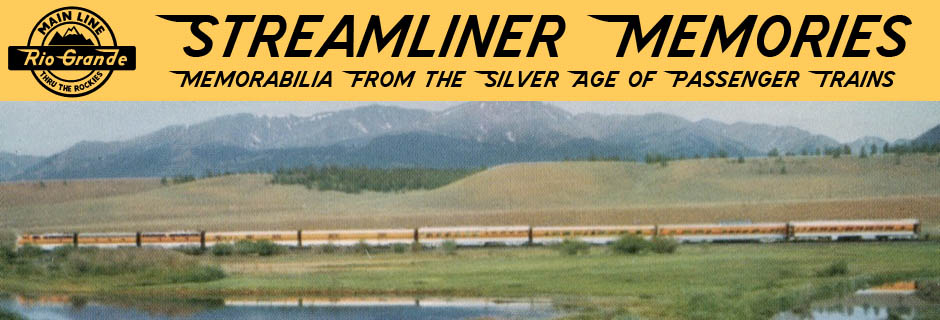By the mid-1950s, Burlington was regularly issuing new timetables in May (which generally went into effect in the last days of April) and November (which generally went into effect in the last days of October), so it is odd to have a timetable dated February (which, in fact, went into effect on February 1). The main difference from the November 1957 timetable is that Burlington merged the Chicago-Lincoln Nebraska Zephyr and the Chicago-Denver Coloradan into one train.
 Click image to download a 2.7-MB PDF of this timetable.
Click image to download a 2.7-MB PDF of this timetable.
In 1957, the Nebraska Zephyr left Chicago at 9:30 am and the Coloradan at 11:20 am. As a merged train, they compromised and left at 10:30 am. The eastbound Coloradan had arrived in Chicago at 7:55 pm and the Nebraska Zephyr 8:45 pm while the merged train arrived at 8:20.
Passengers on both trains lost time due to this merger, but Nebraska Zephyr passengers lost the most. Their westbound train had previously taken 9-1/3 hours to get to Lincoln but after the merger required 3 hours more. Eastbound was a little better but still added 50 minutes to the train’s time. More than 1-1/2 hours was added to the westbound Coloradan‘s time and about a half hour was added eastbound.
The old Coloradan timetable had a 1-1/2 hour layover in Omaha to shuffle cars around. The new one increases this to 1-5/6 hours westbound and 2-5/6 hours eastbound.
One of the reasons it was so slow is that it really was still two trains that overlapped slightly. The streamlined Nebraska Zephyr went from Chicago to Omaha. There, heavyweight sleepers and coaches for the Coloradan were added. The train proceeded to Lincoln where the Zephyr cars were removed. The extra layovers in Omaha were partly to shuffle cars around.
The westbound Coloradan‘s heavyweight cars weren’t added until 11:45 pm at Omaha, so Nebraska Zephyr passengers weren’t subject to the indignity of having old-fashioned cars visible on their supposedly modern train. Eastbound weren’t so lucky as the heavyweight cars weren’t removed until the train arrived in Omaha at 8:30 am, so the mixed heavyweight and lightweight consists were visible during a few hours of daylight.
Passengers going from Chicago to Denver or vice versa had to change cars in Omaha or Lincoln no matter whether they were in sleeping cars or coaches. The train had no sleeping cars east of Omaha and the lightweight Nebraska Zephyr coaches only went as far west as Lincoln so Colorado passengers had to change to or from heavyweight coaches there or in Omaha.
All of these changes must have discouraged ridership. Ridership was declining already and Burlington may have reasoned that anyone who wanted to take a fast train would take the Denver Zephyr or Ak-Sar-Ben Zephyr. The question posed by this timetable is why Burlington decided to make the change in February instead of when it usually issued a new timetable in late April.

I have no firsthand knowledge, but as for the “why” for what CBQ did, a number of possibilities occur:
1. I have a hunch that these trains existed mainly to serve the smaller communities that the DZ or other high end trains did not. I doubt many rode Chicago to Lincoln or Chicago to Denver on this train.
2. CBQ may have had some regulatory hurdles to clear in combining the two trains (really more like dropping one of them). Once they were given the all clear, they needed to issue new schedule pamphlets.
3. And of course, the real reason trains like the Coloradan held on as long as they did: head end traffic.